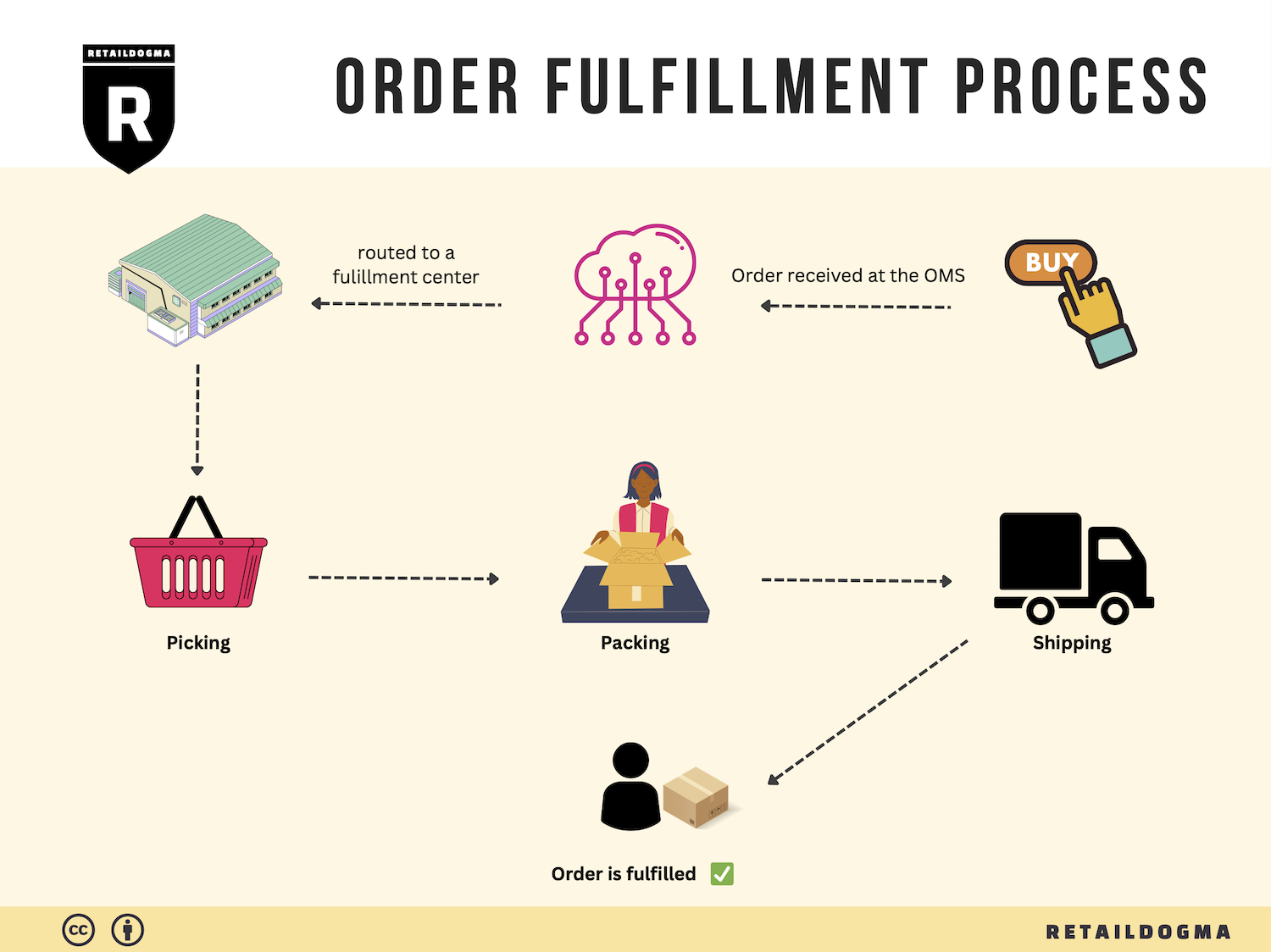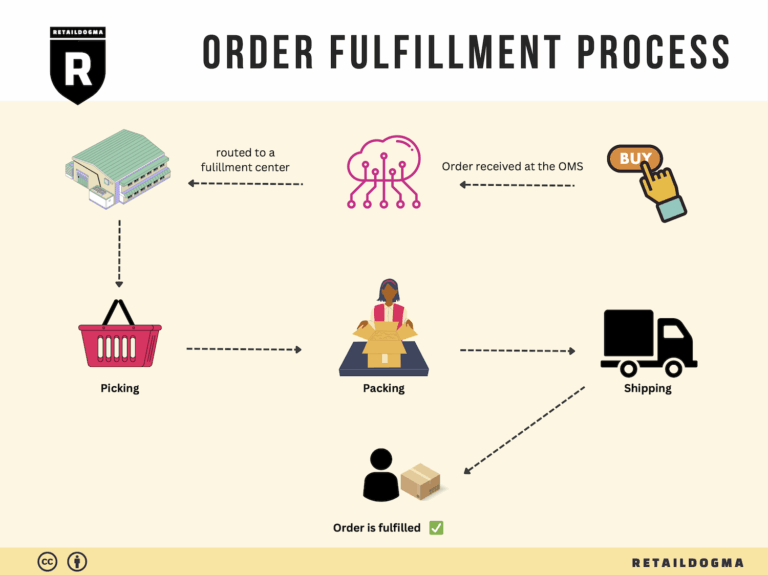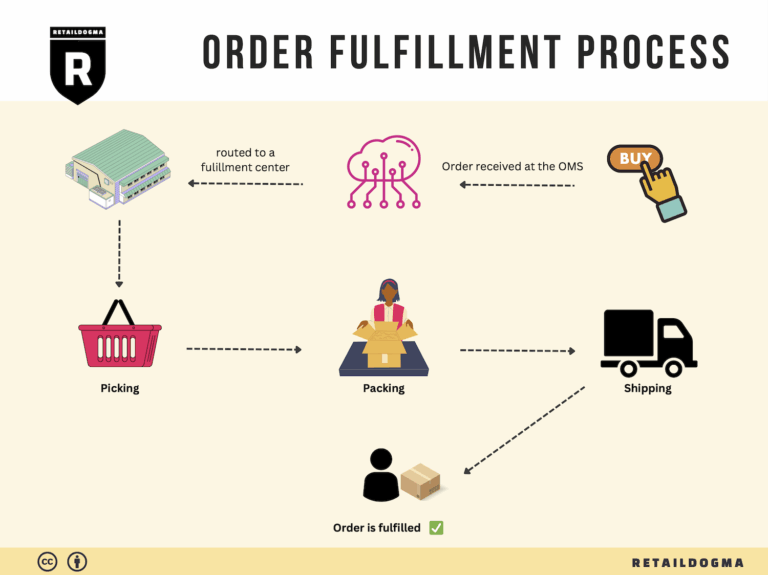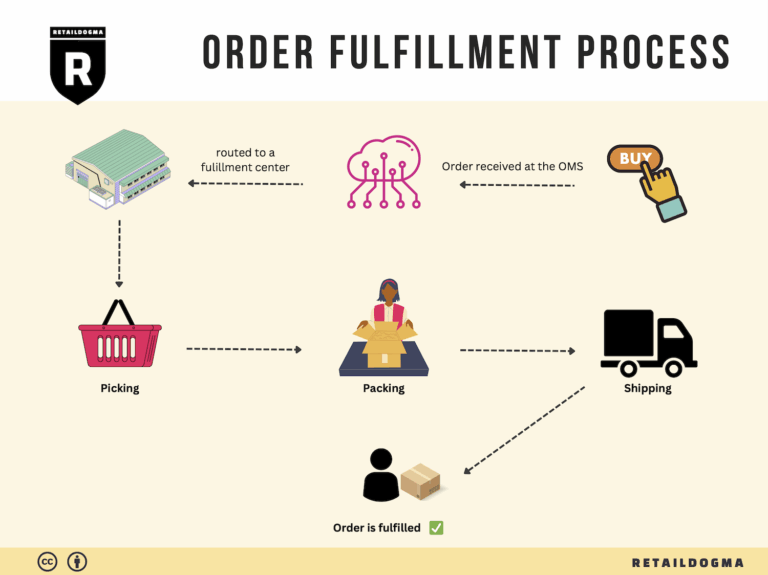How Order Fulfillment Works: A Step-by-Step Guide for Businesses
What is E-commerce Fulfillment? An Introduction for Growing Businesses
Understanding E-commerce Fulfillment: A Key to Scaling Your Business
As an e-commerce business owner, you may find yourself grappling with the overwhelming task of packing and shipping orders. The excitement of growing sales can quickly turn into a logistical nightmare, where the joy of fulfilling customer demands is overshadowed by the complexities of inventory management, shipping deadlines, and packaging requirements. This is where e-commerce fulfillment comes into play.
At its core, fulfillment is the process of getting a product from your inventory to your customer’s doorstep. It encompasses a wide range of activities, including receiving inventory, storing products, picking and packing orders, and managing shipping logistics. Efficient fulfillment is critical for maintaining customer satisfaction, especially in an era where consumers expect rapid delivery and seamless service.
This guide aims to demystify the various aspects of e-commerce fulfillment, focusing on the unique challenges and opportunities faced by growing businesses. We will explore different fulfillment models, such as Fulfillment by Amazon (FBA) and third-party logistics (3PL), to help you understand which option might be best suited for your needs. Each model has its own advantages and disadvantages, and recognizing these can empower you to make informed decisions.
Additionally, we will delve into the core services associated with fulfillment, including inventory management, order processing, and shipping solutions. Understanding these services will enable you to streamline operations and enhance your customer experience.
Choosing the right fulfillment partner is another crucial aspect we will address. The landscape is competitive, and aligning with a partner that understands your business goals can make all the difference. Factors to consider include reliability, technology integration, and the ability to scale with your growth.
Finally, we will discuss pricing structures within the fulfillment landscape. Understanding the costs associated with different fulfillment options will help you budget effectively and maximize your profitability.
The ultimate goal of this guide is to empower e-commerce businesses like yours to make smart, strategic decisions about logistics. By gaining clarity on fulfillment processes and models, you can focus on what truly matters—growing your business and delighting your customers. Let’s dive in and explore the world of e-commerce fulfillment together!

What You’ll Learn In This Guide
- What is E-commerce Fulfillment? An Introduction for Growing Businesses
- The Order Fulfillment Process: From ‘Buy’ Button to Customer’s Door
- Comparing Fulfillment Models: In-House vs. 3PL vs. Dropshipping
- A Deep Dive into Amazon FBA: Pros, Cons, and Who It’s For
- Core Services Offered by Fulfillment Centers
- How to Choose a Fulfillment Partner: A 6-Point Checklist
- Understanding Fulfillment Pricing: A Breakdown of Common Fees
- Frequently Asked Questions (FAQs) about Fulfillment
- Conclusion: Is Outsourcing Fulfillment the Right Move for Your Business?
- Important Disclaimer
The Order Fulfillment Process: From ‘Buy’ Button to Customer’s Door
1. Receiving Inventory
The order fulfillment process begins with receiving inventory at the fulfillment center. This step involves the arrival of products from manufacturers or suppliers, which are then unloaded, inspected, and recorded in the inventory management system. Each item is assigned a unique Stock Keeping Unit (SKU), which simplifies tracking and organization throughout the fulfillment process.
Importance: This step is crucial as it sets the foundation for the entire supply chain. Accurate receiving ensures that inventory levels are correct, preventing stockouts or excess stock that can disrupt operations and customer satisfaction.
Key Term: SKU (Stock Keeping Unit) – A unique identifier for each product that facilitates tracking and inventory management.
2. Warehouse Storage
Once the inventory is received, products are stored in a systematic manner within the warehouse. Advanced fulfillment centers utilize high-tech shelving systems and automated storage solutions to optimize space and improve retrieval efficiency. Items are organized based on various factors, such as product type, demand frequency, and size, ensuring that frequently ordered items are easily accessible.
Importance: Efficient storage is vital for minimizing retrieval times during order picking. A well-organized warehouse can significantly enhance operational efficiency, reduce labor costs, and improve overall fulfillment speed, which is essential for meeting customer expectations in today’s competitive e-commerce landscape.
Key Term: ABC Analysis – A method of categorizing inventory based on importance and value, helping to determine the best storage locations for various items.
3. Order Picking
When a customer places an order, the next step is order picking. This involves selecting the correct items from the warehouse to fulfill the order. Workers or automated systems use pick lists, which detail the items and their locations, to gather the necessary products. The picking process can vary, with methods such as single order picking, batch picking, or wave picking being employed based on order volume and complexity.
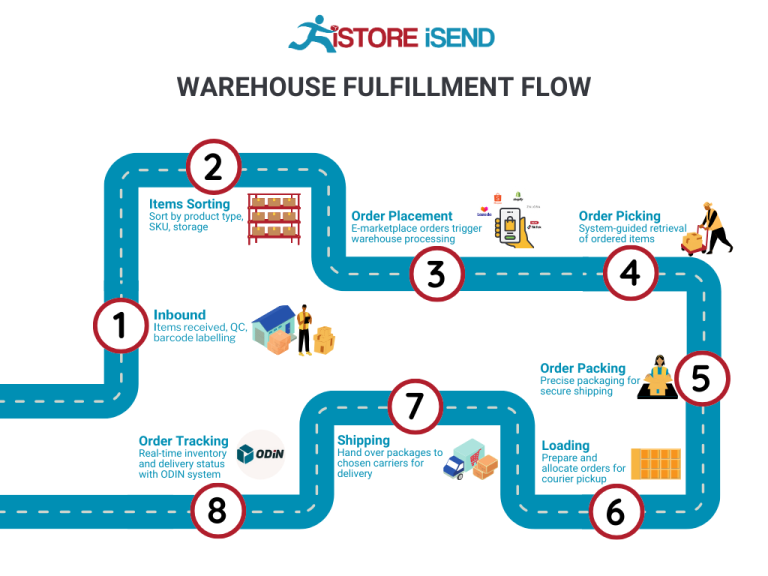
Importance: Accurate and efficient order picking is crucial for maintaining high fulfillment accuracy and customer satisfaction. Mistakes in this step can lead to incorrect orders, resulting in returns and dissatisfied customers.
Key Term: Pick Lists – Documents or digital displays that guide warehouse workers in selecting the correct items for each order, enhancing picking efficiency.
4. Order Packing
After the items are picked, they are moved to the packing area where they are prepared for shipment. This step involves checking the items against the order details to ensure accuracy, followed by packaging them securely for transit. The packing process may include adding protective materials, labeling, and preparing shipping documentation.
Importance: Proper packing is essential to prevent damage during shipping and to ensure that the order reaches the customer in perfect condition. Additionally, efficient packing can help reduce shipping costs by optimizing package size and weight.
Key Term: Packing Slip – A document included with the package that lists the contents of the shipment, providing transparency and helping customers verify their order.
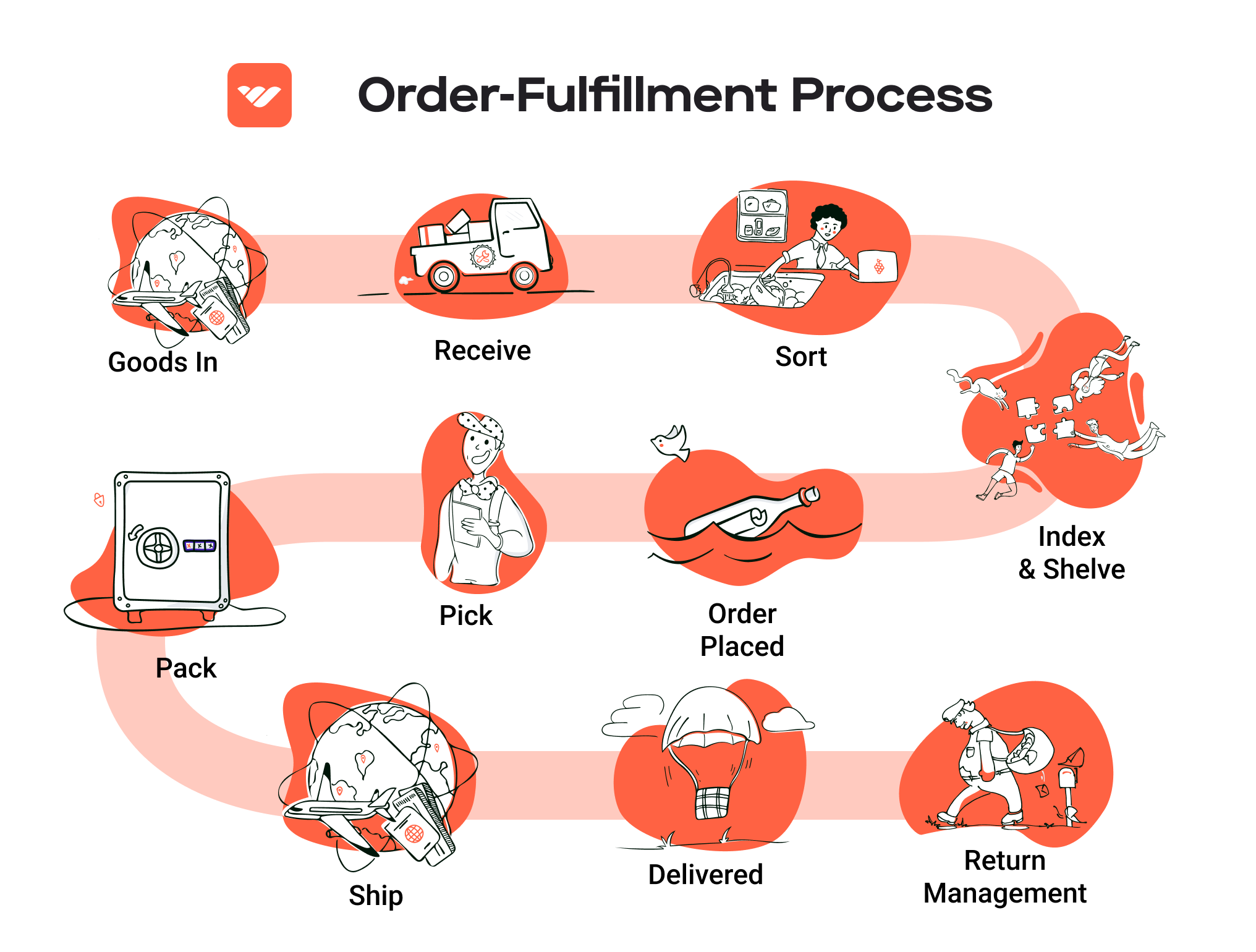
5. Shipping & Delivery
The final step in the order fulfillment process is shipping and delivery. Once packed, orders are sorted based on their delivery destination and handed over to carriers for transportation. This may involve using Amazon’s delivery network, third-party logistics (3PL) providers, or a combination of both. The choice of shipping method can impact delivery speed and cost, so businesses must strategically plan their logistics.
Importance: Timely shipping and delivery are critical for customer satisfaction and loyalty. In an era where consumers expect fast, reliable service, businesses must continually optimize their shipping strategies to remain competitive.
Key Term: Last-Mile Delivery – The final step of the shipping process where the package is delivered from a distribution center to the customer’s doorstep, often presenting the greatest challenges and costs in logistics.
Understanding and optimizing each step of the order fulfillment process is essential for e-commerce businesses, especially in a competitive environment like Atlanta where Amazon’s fulfillment centers dominate. By paying close attention to each stage, businesses can enhance operational efficiency, improve customer satisfaction, and ultimately drive growth in their e-commerce ventures.
Comparing Fulfillment Models: In-House vs. 3PL vs. Dropshipping
Fulfillment Model Comparison
| Model | Who Handles Inventory | Best For (Business Stage) | Key Advantage | Key Disadvantage |
|---|---|---|---|---|
| In-House Fulfillment | Business owns and manages inventory | Established businesses with stable sales | Full control over inventory and processes | High overhead costs and labor management challenges |
| Third-Party Logistics (3PL) | 3PL provider manages inventory | Growing businesses and startups | Scalability and reduced operational burden | Less control over inventory and potential misalignment with brand values |
| Dropshipping | Supplier handles inventory | Startups or low-capital businesses | Low startup costs and no inventory risk | Lower profit margins and reliance on supplier reliability |
In-House Fulfillment
In-house fulfillment involves a business managing its own inventory and logistics operations. This model is often adopted by established businesses that have stable sales and a clear understanding of their supply chain dynamics. The primary advantage of in-house fulfillment is the full control it provides over inventory management, order processing, and shipping. Companies can ensure that their brand standards are met at every step of the fulfillment process, from packaging to shipping. Additionally, owning the fulfillment process allows businesses to implement specific systems and technologies that align with their operational goals.
However, in-house fulfillment comes with significant disadvantages. The most notable is the high overhead costs associated with warehousing, staffing, and technology investments. Businesses must manage their workforce, which can lead to challenges in labor management and turnover. Moreover, as demand fluctuates, maintaining optimal inventory levels can be complex and costly, leading to overstocking or stockouts. For businesses looking to scale quickly or those with variable demand, in-house fulfillment may not be the most efficient option.
Third-Party Logistics (3PL)
Third-party logistics (3PL) providers offer a solution where businesses outsource their inventory management and logistics operations to specialized firms. This model is particularly beneficial for growing businesses and startups that want to focus on core activities without the burden of managing logistics. The key advantage of using a 3PL provider is scalability; businesses can easily adjust their logistics operations based on fluctuating demand without the need to invest heavily in warehousing or staff.
3PL providers often have established networks and technologies that can streamline the fulfillment process, making it easier for businesses to expand into new markets or scale operations. However, the trade-off is that businesses relinquish some control over their inventory and fulfillment processes. This can lead to potential misalignment with brand values, especially if the 3PL provider does not meet the same quality standards. Additionally, businesses may face challenges in communication and coordination, which can affect order accuracy and customer satisfaction.
Dropshipping
Dropshipping is a fulfillment model where the retailer does not hold any inventory but instead relies on suppliers to fulfill customer orders directly. This model is particularly appealing for startups or businesses with limited capital, as it requires very low upfront investment and eliminates the risks associated with holding inventory. The primary advantage of dropshipping is that it allows entrepreneurs to test product ideas and market demand without incurring significant financial risks.
However, dropshipping comes with its own set of challenges. One of the main disadvantages is the lower profit margins, as suppliers typically take a larger cut of the sale price. Additionally, businesses are heavily reliant on their suppliers for product quality, shipping speed, and inventory management. Any issues on the supplier’s end can lead to delays or dissatisfaction among customers, which can harm the retailer’s reputation. Furthermore, the lack of control over the fulfillment process can make it difficult for businesses to maintain consistent branding and customer experience.
Conclusion
When choosing a fulfillment model, e-commerce business owners must weigh the advantages and disadvantages of each option in the context of their specific needs and growth stage. In-house fulfillment offers control but at a higher cost and complexity, while 3PL can provide scalability and efficiency but may compromise some level of brand alignment. Dropshipping offers a low-risk entry point into e-commerce but can lead to challenges in profit margins and supplier reliability. By understanding these models and their implications, businesses can make informed decisions that align with their operational goals and customer expectations.
A Deep Dive into Amazon FBA: Pros, Cons, and Who It’s For
Understanding Fulfillment by Amazon (FBA)
Fulfillment by Amazon (FBA) is a service that allows e-commerce sellers to store their products in Amazon’s fulfillment centers. When a customer places an order, Amazon takes care of storage, packaging, and shipping on behalf of the seller. This service enables sellers to leverage Amazon’s extensive logistics network and customer base while focusing on growing their business.
How FBA Works:
-
Product Listing and Preparation: Sellers create product listings on Amazon and send their inventory to Amazon’s fulfillment centers. Each product must be labeled according to Amazon’s specifications.
-
Storage: Once received, products are stored in Amazon’s warehouses. Sellers are charged storage fees based on the amount of space their inventory occupies.
-
Order Processing: When a customer orders a product, Amazon’s system automatically picks, packs, and ships the item from the nearest fulfillment center. This process is highly automated, utilizing advanced robotics and inventory management systems.
-
Customer Service and Returns: Amazon also manages customer service inquiries and handles returns, providing a seamless experience for both sellers and buyers.
-
Payment: After the sale, Amazon collects payment from the customer and deposits the proceeds (minus fees) into the seller’s account.
Pros of Using FBA
-
Prime Eligibility: Products fulfilled by Amazon are eligible for Amazon Prime, which can significantly boost sales. Prime members often prefer Prime-eligible products due to the promise of fast and free shipping.
-
Customer Trust: Leveraging Amazon’s brand can enhance customer trust. Buyers are more likely to purchase from sellers using FBA, as they associate the service with reliability and quality customer service.
-
Multi-Channel Fulfillment: FBA can be used for fulfilling orders from other sales channels, such as eBay or a seller’s own website. This allows sellers to centralize their inventory management and logistics under Amazon’s umbrella.
-
Scalability: FBA allows businesses to scale quickly without the burden of managing storage, shipping, and customer service. Sellers can focus on marketing and product development rather than logistics.
-
Global Reach: With Amazon’s international fulfillment network, sellers can easily reach customers in different countries, expanding their market presence.
Cons of Using FBA
-
High Fees: While FBA provides many advantages, it comes at a cost. Sellers incur various fees, including storage fees and fulfillment fees for each unit sold. These costs can add up, particularly for low-margin products.
-
Strict Inventory Rules: Amazon has stringent guidelines regarding inventory management, including labeling, packaging, and storage. Non-compliance can lead to penalties or disruptions in service.
-
Commingling Risks: FBA often commingles inventory, meaning that products from different sellers may be stored together. This can lead to issues if a seller’s product is damaged or misidentified, affecting their reputation and sales.
-
Dependence on Amazon: Relying solely on FBA can be risky. Changes in Amazon’s policies, fee structures, or algorithms can have significant impacts on a seller’s business. Sellers may find themselves at the mercy of Amazon’s decisions.
-
Limited Control Over Shipping: While Amazon handles shipping, sellers have limited control over the fulfillment process. This can lead to inconsistencies in shipping speed and packaging quality, which can affect customer satisfaction.
Who is FBA Best For?
Fulfillment by Amazon is particularly beneficial for:
-
Small to Medium-Sized E-commerce Businesses: Those without the resources to manage their own logistics can leverage FBA to access Amazon’s infrastructure and customer base.
-
Sellers with High-Volume Sales: Businesses that sell large quantities of products can benefit from the economies of scale offered by FBA, as the per-unit costs decrease with higher volumes.
-
Businesses Looking for Scalability: Companies aiming for rapid growth can utilize FBA to handle increased order volumes without the need for significant upfront investment in warehousing and logistics.
-
Sellers of Perishable or Seasonal Products: FBA allows for quick fulfillment, which is essential for products with a short shelf life or those that peak during specific seasons.
-
Brands Seeking to Enhance Visibility: Sellers looking to build brand credibility and visibility can benefit from being part of Amazon’s trusted network.
In conclusion, Fulfillment by Amazon presents a compelling option for many e-commerce sellers, offering both significant advantages and notable challenges. It is essential for business owners to carefully weigh these factors against their specific needs and capabilities. For those who can navigate the complexities of FBA, the rewards can be substantial, enabling them to grow their businesses in a competitive landscape.
Core Services Offered by Fulfillment Centers
Inventory Management & Warehousing
Inventory management and warehousing are foundational services provided by fulfillment centers, allowing e-commerce businesses to efficiently store and track their products. This service involves the systematic control of stock levels, ensuring that businesses maintain optimal inventory without overstocking or running out of essential items.
Benefits:
-
Space Optimization: Fulfillment centers utilize advanced storage solutions, such as high-density shelving and automated systems, to maximize space. This means businesses can store more products in a smaller footprint, reducing overhead costs associated with leasing larger warehouses.
-
Real-Time Tracking: With sophisticated inventory management systems, fulfillment centers provide real-time data on stock levels, allowing businesses to make informed decisions regarding restocking and order fulfillment. This agility helps prevent stockouts and ensures customer satisfaction.
-
Scalability: As e-commerce businesses grow, their inventory needs can fluctuate significantly. Fulfillment centers offer scalable solutions, allowing businesses to increase or decrease their storage capacity based on demand without the burden of managing additional real estate.
-
Compliance and Safety: Fulfillment centers often adhere to strict regulatory standards for inventory storage, ensuring that products are stored safely and correctly. This compliance reduces risks associated with product damage or contamination.
Pick and Pack Services
Pick and pack services involve the selection of items from inventory (picking) and packing them for shipment to customers. This process is critical for fulfilling customer orders accurately and efficiently.
Benefits:
-
Efficiency and Speed: Fulfillment centers employ a combination of automated systems and trained staff to streamline the picking process. This efficiency translates to faster order processing times, which is essential in today’s competitive e-commerce landscape where consumers expect quick delivery.
-
Accuracy: Advanced technology, such as barcode scanning and automated picking systems, helps ensure that the correct items are selected for each order. This accuracy reduces the likelihood of returns and increases customer satisfaction.
-
Custom Packaging Options: Many fulfillment centers offer customizable packing solutions, allowing businesses to brand their packaging and create a unique unboxing experience. This personalization can enhance customer loyalty and brand recognition.
-
Error Reduction: By utilizing systematic processes and technology, fulfillment centers can significantly reduce the chances of picking errors. This not only saves costs associated with returns and replacements but also improves the overall customer experience.
Kitting and Assembly
Kitting and assembly services involve combining multiple products into a single package or kit before shipping. This service is particularly beneficial for businesses that offer bundled products or need specific items to be assembled before delivery.
Benefits:
-
Product Bundling: Kitting allows businesses to create attractive product bundles that can increase average order value. For example, offering complementary products as a kit can entice customers to purchase more items at once.
-
Time Savings: Outsourcing kitting and assembly to fulfillment centers saves businesses valuable time and labor. Instead of managing assembly in-house, companies can focus on core operations like marketing and customer engagement.
-
Quality Control: Fulfillment centers often have quality control measures in place during the kitting process. This ensures that all items in a kit meet the desired specifications, reducing the risk of sending defective products to customers.
-
Flexibility: Businesses can easily adjust their kitting strategies based on seasonal demand or promotional campaigns. This flexibility allows them to respond quickly to market trends without the need for extensive logistical changes.
Returns Management (Reverse Logistics)
Returns management, or reverse logistics, refers to the processes involved in handling returned products efficiently. This service is increasingly important for e-commerce businesses, as returns can significantly impact profitability.
Benefits:
-
Streamlined Returns Process: Fulfillment centers manage the entire returns process, from receiving returned items to inspecting and restocking them. This streamlining reduces the burden on e-commerce businesses, allowing them to focus on growth.
-
Customer Satisfaction: A smooth returns process enhances the customer experience. When customers know they can return items easily, they are more likely to make purchases, knowing they have the option to return if necessary.
-
Data Insights: Fulfillment centers can provide valuable data on return trends, helping businesses understand why products are being returned. This information can be used to improve product offerings, adjust marketing strategies, and reduce future returns.
-
Cost Recovery: Efficient returns management helps businesses recover value from returned products, whether through resale, refurbishment, or recycling. This recovery can mitigate losses associated with returns and improve overall profitability.
In summary, fulfillment centers offer a suite of core services that are vital for e-commerce businesses aiming to scale efficiently. By leveraging these services, companies can optimize their operations, enhance customer satisfaction, and ultimately drive growth in a competitive marketplace.
How to Choose a Fulfillment Partner: A 6-Point Checklist
Location & Warehouse Network
Importance: The geographical location of your fulfillment partner’s warehouses can significantly affect shipping times and costs. A partner located near your target market can help you meet customer expectations for fast delivery, especially in a competitive landscape where consumers demand quick shipping options.
Questions to Ask:
– Where are your fulfillment centers located, and how does that align with my target market?
– Can you provide regional shipping options to optimize delivery times and costs?
– What is your average shipping time to key areas where my customers are located?
Technology & Integrations
Importance: A fulfillment partner’s technology stack should seamlessly integrate with your existing systems (like e-commerce platforms, inventory management tools, and ERP systems). This ensures real-time inventory tracking, order processing efficiency, and accurate data analytics, which are crucial for scaling operations.
Questions to Ask:
– What technology do you use for inventory management, order processing, and shipping?
– Can your systems integrate with my current e-commerce platform? If so, what is the process for integration?
– Do you offer APIs for real-time tracking and reporting? How frequently is data updated?
Specializations (e.g., Cold Storage, Oversized Items)
Importance: Different businesses have unique fulfillment needs based on their product types. If you sell perishable goods, heavy machinery, or oversized items, it’s essential to choose a partner with the appropriate facilities and expertise.
Questions to Ask:
– What types of products do you specialize in fulfilling? Do you have experience with my specific product category?
– Do you have specialized storage options, such as cold storage or handling for fragile items?
– Can you accommodate seasonal fluctuations in demand for my products?
Scalability & Capacity
Importance: As your business grows, your fulfillment needs will change. A good fulfillment partner should be able to scale operations to handle increased order volumes without compromising service quality.
Questions to Ask:
– What is your current capacity for order fulfillment, and how do you handle peak seasons or unexpected surges in demand?
– Can you provide examples of how you’ve scaled for other clients in the past?
– What are your policies for handling backorders or stockouts?
Pricing and Contracts
Importance: Understanding the pricing structure and contract terms is crucial for budgeting and financial forecasting. Look for transparency in pricing and be wary of hidden fees that could impact your bottom line.
Questions to Ask:
– What is your pricing model (e.g., per order, per item, storage fees)? Are there any additional fees I should be aware of?
– Can you provide a detailed breakdown of all potential costs?
– What are the contract terms? Is there flexibility to renegotiate or exit the agreement if my business needs change?
Customer Support & Reviews
Importance: Reliable customer support can make a significant difference in your operational efficiency. A fulfillment partner should offer responsive and knowledgeable support to address any issues that arise quickly.
Questions to Ask:
– What customer support channels do you offer (e.g., phone, email, live chat)? What are your typical response times?
– Can you share any customer testimonials or case studies that highlight your service quality?
– How do you handle disputes or issues that arise during the fulfillment process?
Conclusion
Choosing the right fulfillment partner is a critical step for scaling your e-commerce business effectively. By carefully considering these six essential factors—location and warehouse network, technology and integrations, specializations, scalability, pricing, and customer support—you can make an informed decision that aligns with your operational needs and business goals. Take the time to ask the right questions and evaluate potential partners thoroughly to ensure a successful partnership that supports your growth and enhances your customer experience.
Understanding Fulfillment Pricing: A Breakdown of Common Fees
Initial Setup Fees
When partnering with a fulfillment center, businesses often encounter initial setup fees. These fees are charged to establish your account and set up the necessary systems to manage your inventory. The setup process typically includes account configuration, integration with your e-commerce platform, and training on how to use the fulfillment system effectively.
The calculation of initial setup fees can vary significantly based on the complexity of your operations and the specific requirements of the fulfillment center. Some providers may charge a flat fee, while others may base the cost on the volume of products being handled or the number of SKUs. It’s crucial to clarify what is included in these fees—such as software access, training, and any initial inventory assessments—to avoid unexpected charges.
Receiving Fees
Receiving fees are charged when your products arrive at the fulfillment center. This fee covers the labor and resources required to unload, inspect, and store your inventory. The process involves scanning incoming items, checking for damages, and sorting products into the appropriate storage areas.
Typically, receiving fees are calculated based on the number of pallets or individual items received. Some fulfillment centers may implement a tiered pricing model where the first X number of units are charged at one rate, and any additional units incur a higher fee. Understanding these costs is vital, especially if your business has fluctuating inventory levels, as it can significantly impact your overall fulfillment expenses.
Storage Fees (per pallet/bin)
Storage fees are incurred for the space your inventory occupies within the fulfillment center. These fees are typically assessed on a per-pallet or per-bin basis and can be charged monthly or quarterly. The storage fee structure often depends on the size of the products and the duration they remain in the facility.
To calculate storage fees, fulfillment centers usually consider the total volume of space your products occupy. Some providers may also charge for overflow or peak season storage, which can increase costs during high-demand periods. Businesses should be aware of inventory turnover rates, as excessive storage can lead to increased costs and potentially higher fees for long-term storage.
Pick & Pack Fees (per item/order)
Pick and pack fees are charged for the labor involved in selecting items from storage and preparing them for shipment. This process includes picking the correct products, packing them securely, and labeling the packages for delivery. The complexity of this operation can vary based on the types of items being handled, the number of items per order, and any special packaging requirements.
Typically, pick and pack fees are calculated on a per-item or per-order basis. For example, a fulfillment center may charge a flat fee for the first item in an order and an additional fee for each item after that. Understanding these fees is essential, as they can add up quickly, especially for businesses with a high volume of small orders. It’s advisable to negotiate favorable terms based on your expected order volume and item complexity.
Shipping Fees
Shipping fees encompass the costs associated with transporting packages from the fulfillment center to customers. These fees can vary widely based on factors such as package dimensions, weight, shipping speed, and destination. Fulfillment centers often leverage relationships with carriers to secure competitive shipping rates, which can be passed on to their clients.
Shipping fees may also include additional charges for services like insurance, signature confirmation, or special handling. To calculate these fees, fulfillment centers typically use a combination of carrier rates and their own handling fees. It’s important for businesses to understand these costs, as they can significantly impact the overall pricing structure and customer satisfaction regarding delivery times.
Tips for Getting an Accurate Quote
-
Provide Detailed Information: When requesting a quote, provide as much detail as possible about your inventory, expected order volume, and any special requirements. This will help fulfillment centers give you a more accurate estimate.
-
Ask About Hidden Fees: Inquire about any additional fees that may not be included in the initial quote, such as long-term storage fees, seasonal rate increases, or penalties for non-compliance with inventory guidelines.
-
Compare Providers: Don’t settle for the first quote you receive. Compare multiple fulfillment centers to understand the market rates and find the best fit for your business needs.
-
Negotiate Terms: Depending on your order volume and business model, there may be room for negotiation on fees. Discuss potential discounts for higher volumes or long-term contracts.
-
Review Contracts Carefully: Before signing any agreements, carefully review all terms and conditions related to fees to avoid unexpected costs down the line.
By understanding the various fulfillment pricing models and following these tips, e-commerce businesses can better manage their logistics costs and enhance their operational efficiency.
Frequently Asked Questions (FAQs) about Fulfillment
1. What is an Amazon Fulfillment Center?
An Amazon Fulfillment Center is a large warehouse where Amazon stores products sold by its sellers. These centers handle the entire process of order fulfillment, including receiving inventory, storing it, picking and packing orders, and shipping them directly to customers. The centers are equipped with advanced technology and automation systems to ensure efficient and rapid processing of orders.
2. How do Amazon Fulfillment Centers in Atlanta operate?
Amazon Fulfillment Centers in Atlanta operate by utilizing a highly automated system that includes robotics and AI-driven inventory management. Products are received, scanned, and sorted before being stored in optimized shelving systems. When an order is placed, items are picked, packed, labeled, and dispatched for delivery, ensuring quick turnaround times for customers.
3. What are the benefits of using Fulfillment by Amazon (FBA)?
Using Fulfillment by Amazon (FBA) allows sellers to take advantage of Amazon’s extensive logistics network. Benefits include faster shipping times, access to Amazon Prime customers, reduced shipping costs, and the ability to leverage Amazon’s customer service and returns handling. This can significantly enhance a seller’s visibility and sales potential on the platform.
4. What is the difference between a warehouse and a fulfillment center?
While both warehouses and fulfillment centers store products, their functions differ. A warehouse primarily focuses on storing goods for long-term inventory management, whereas a fulfillment center is designed for processing and shipping orders quickly. Fulfillment centers have advanced systems for picking, packing, and shipping products directly to customers, often using automation to expedite these processes.
5. How much do fulfillment services cost?
The cost of fulfillment services varies based on several factors, including the volume of orders, storage space required, and additional services such as kitting or custom packaging. On average, businesses can expect to pay for storage fees (per cubic foot), fulfillment fees (per order or item), and any optional services. It’s important to compare different providers to find a solution that fits your budget and operational needs.
6. How can businesses in Atlanta benefit from Amazon’s fulfillment network?
Businesses in Atlanta can benefit from Amazon’s fulfillment network by leveraging faster shipping capabilities, which can enhance customer satisfaction and loyalty. Additionally, the presence of multiple fulfillment centers creates opportunities for local businesses to collaborate, increasing job creation and economic growth in the region.
7. What challenges do businesses face when using Amazon Fulfillment Centers?
Challenges include increased warehousing costs due to high demand for space, competition in shipping speed expectations set by Amazon, and labor shortages as smaller companies compete for talent. Additionally, businesses that rely heavily on Amazon’s ecosystem may face risks related to policy changes, fee increases, or operational disruptions.
8. What is a third-party logistics provider (3PL)?
A third-party logistics provider (3PL) is a company that offers logistics services to businesses, including warehousing, order fulfillment, and transportation. 3PLs can help e-commerce businesses manage their supply chain more effectively by providing flexible solutions tailored to their specific needs, often complementing services provided by Amazon.
9. How does Amazon’s focus on automation impact fulfillment?
Amazon’s focus on automation significantly enhances the efficiency and speed of order processing within its fulfillment centers. Automated systems can quickly pick, pack, and ship products, reducing human error and processing times. This allows Amazon to maintain its competitive edge in the e-commerce market by meeting customers’ demands for rapid delivery.
10. How can businesses optimize their fulfillment strategy in Atlanta?
To optimize their fulfillment strategy, businesses in Atlanta should consider diversifying their logistics options beyond Amazon, such as using 3PL providers for customized solutions. Additionally, adopting multi-carrier shipping strategies, improving inventory management, and leveraging local partnerships can enhance operational efficiency and reduce costs while meeting customer expectations for timely delivery.
Conclusion: Is Outsourcing Fulfillment the Right Move for Your Business?
Evaluating the Benefits of Outsourcing Fulfillment
Outsourcing fulfillment can be a game-changer for e-commerce businesses looking to scale efficiently. One of the primary benefits is time savings. By partnering with a fulfillment service, businesses can offload the complexities of warehousing, picking, packing, and shipping. This allows you to focus on core activities like product development, marketing, and customer engagement, ultimately driving growth.
Additionally, outsourcing provides scalability. As your business grows, so do the demands on your logistics. A reliable fulfillment partner can easily accommodate fluctuating order volumes, seasonal spikes, and new product launches without the need for significant upfront investment in infrastructure. This flexibility is critical in a fast-paced e-commerce landscape where customer expectations for rapid delivery are ever-increasing.
Moreover, fulfillment services bring expertise to the table. With specialized knowledge in logistics, inventory management, and shipping strategies, these partners can optimize your operations, reduce costs, and enhance customer satisfaction. They stay updated on the latest trends and technologies, ensuring your business remains competitive.
However, the key to successful outsourcing lies in choosing the right partner. Not all fulfillment services are created equal; it’s crucial to select one that aligns with your business goals, offers transparent pricing, and provides tailored solutions that reflect your brand’s unique needs.
Take Action Today
To determine if a fulfillment partner is the right move for your business, conduct a thorough audit of your current shipping processes. Assess your operational efficiency, shipping costs, and customer satisfaction levels. This evaluation will help you identify gaps and opportunities for improvement. If your findings indicate a need for change, consider reaching out to a trusted fulfillment provider to discuss how they can support your growth. Embrace the potential of outsourcing fulfillment, and position your business for success in today’s competitive market.
Important Disclaimer
⚠️ Important Disclaimer
The information in this guide is for educational purposes. Fulfillment services, pricing, and platform features change frequently. Always conduct your own due diligence and consult with providers directly before making business decisions.
